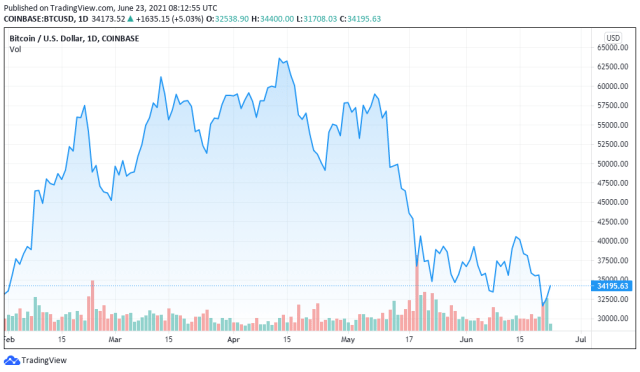
The time has come, book lovers. The time to discuss “time preference,” a key concept that will help you make sense of the world around us. If you already own BTC, you know how it changes your priorities and makes you a more measured individual, focused on the future.
The whole “stacking sats” meme, a staple of Bitcoin culture, is based on this phenomenon. Why are we stacking sats? Because we know those satoshis, the smallest unit in which bitcoin can be divided, will be worth much much more in the future. One satoshi equates to 100 millionth of a whole bitcoin. How much will one of those be worth in 20 years?
Related Reading | Article 7: Is It Obligatory For Vendors To Receive Bitcoin In El Salvador?
In any case, look at how beautiful the recently published Japanese edition of Saifedean Ammous’ “The Bitcoin Standard” is.
Just received JP ver. of “The Bitcoin Standard” fresh out of the printer 🎉
Presale is going well according to the publisher. Thank you 🙏 @saifedean @wiz
刷りたてホヤホヤの見本が届きました!
7/20発売👇
おかげさまで予約販売好調です🙏https://t.co/nRpY9U4Xqb pic.twitter.com/P2PL53FLU7— Teruko (@TerukoNeriki) June 23, 2021
That’s the book we’re about to keep analyzing today, but first…
About The Coolest Book Club On Earth
The Bitcoinist Book Club has two different use cases:
1.- For the superstar-executive-investor on the run, we’ll summarize the must-read books for cryptocurrency enthusiasts. One by one. Chapter by chapter. We read them so you don’t have to, and give you just the meaty bits.
2.- For the meditative bookworm who’s here for the research, we’ll provide liner notes to accompany your reading. After our book club finishes with the book, you can always come back to refresh the concepts and find crucial quotes.
Everybody wins.
So far, we’ve covered:
- Prologue and Chapter 1
- Chapter 2: Primitive Moneys
- Chapter 3, Part 1: Why Gold?
- Chapter 3, Part 2: History
- Chapter 4, Part 1: Gold Standard
- Chapter 4, Part 2: Government Money
- Chapter 4, Part 3: Money and Hyperinflation
And Now Is Time For, “Chapter 5, Part 1: Time Preference“
The previous entry in our journal ended with the definition of sound money, and today we’ll keep exploring that concept. To do that soundly, we need Saifedean Ammous to explain what “time preference” is.
Time preference refers to the ratio at which individuals value the present compared to the future.
…
The lower an individual’s time preference, the more likely he is to engage in investment, to delay gratification, and to accumulate capital. The more capital is accumulated, the higher the productivity of labor, and the longer the time horizon of production.
Great. With that in mind, let’s explore why sound money is important for a society to flourish.
-
First, it protects value across time, which gives people a bigger incentive to think of their future, and lowers their time preference.
-
Second, sound money allows for trade to be based on a stable unit of measurement, facilitating ever-larger markets, free from government control and coercion.
-
Finally, sound money is an essential requirement for individual freedom from despotism and repression, as the ability of a coercive state to create money can give it undue power over its subjects.
Time Preference And The Expected Future Value Of Money
In the not too distant past, people in developing economies understood these concepts with ease because they felt the effects of not using sound money every day. The people in the developed world had trouble grasping them because their systems seemed to work and “the expected future value of money” was nothing they had to worry about. In the present, everyone is feeling the devastation and the fear caused by unsound money.
In a free market where people are free to choose their money, they will choose the form of money most likely to hold its value over time. The better the money is at holding its value, the more it incentivizes people to delay consumption and instead dedicate resources for production in the future, leading to capital accumulation and improvement of living standards, while also engendering in people a low time preference in other, non-economic aspects of their life.
Everybody knows we’re subject to taxation. Few understand that inflation is a hidden tax. However, the trickiest concept of all is that this is “a desirable goal” for modern economists.
The reduction in the purchasing power of money is similar to a form of taxation or expropriation, reducing the real value of one’s money even while the nominal value is constant. In modern economies government-issued money is inextricably linked to artificially lower interest rates, which is a desirable goal for modern economists because it promotes borrowing and investing.
A reduction in “the expected future value of money” makes people “more present-oriented in all their decision making.” The time preference rises, and that opens a huge can of worms for a society.
Inflation Is A Hidden Tax
The law of supply and demand is never wrong. The more money there is, the less each unit is worth.
Unlike all other goods, money’s functions as a medium of exchange, store of value, and unit of account are completely orthogonal to its quantity.
Related Reading | Bitcoinist Book Club: “The Bitcoin Standard” (Prologue and Chapter 1)
And any entity that can create money, will do it. “The temptation to engage in this is too strong.” To make things worse, so far, it has “proved impossible to come up with a form of money of which more cannot be created.” Not that we have to worry about that. We live in the fiat era, creating more coins and bills to inflate the money supply has never been easier.

BTC price chart on Coinbase | Source: BTC/USD on TradingView.com


















